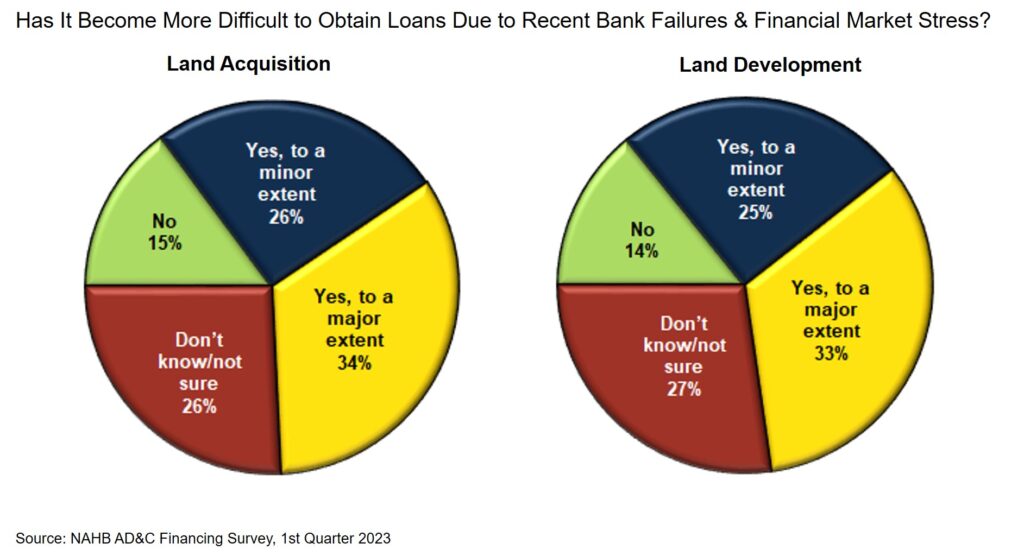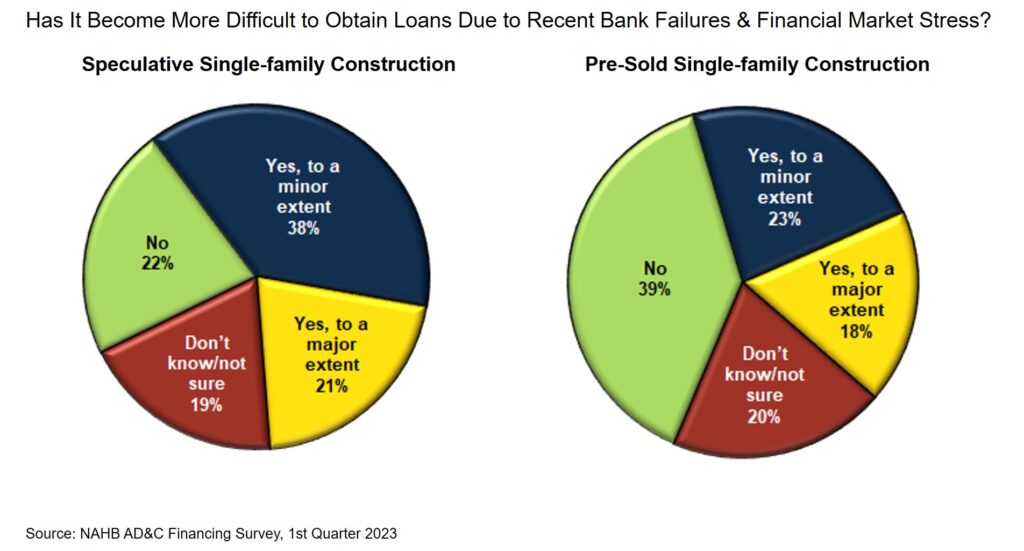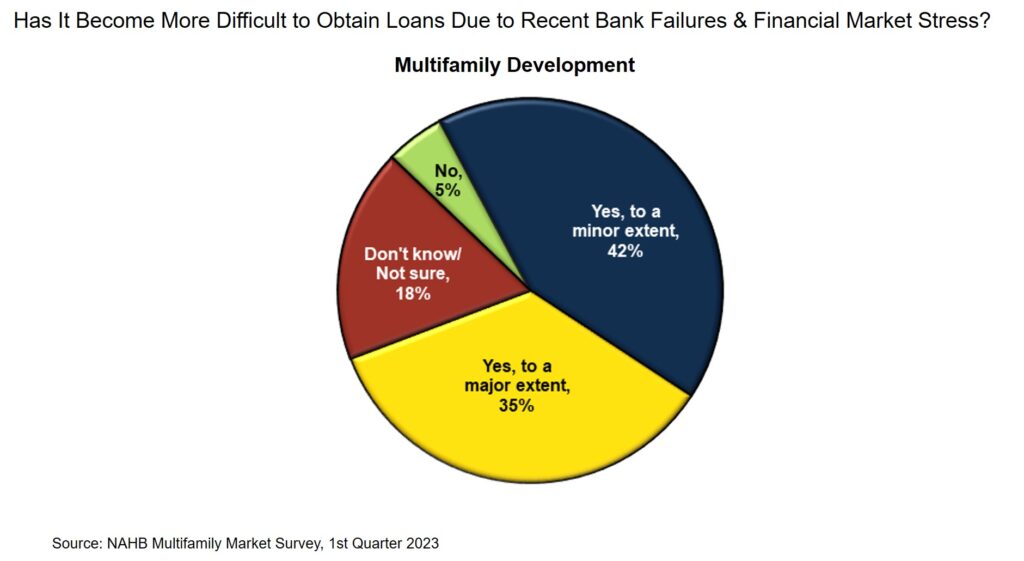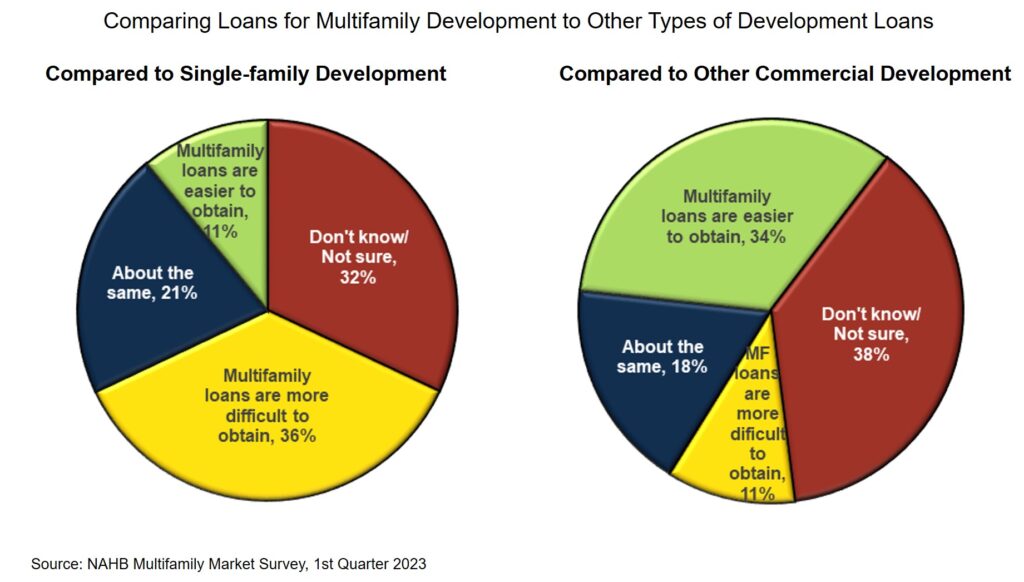The failure of several banks in 2023 and the ensuing stress in U.S. financial markets have had an effect that some builders and developers are beginning to notice, according to two recent NAHB surveys. In one of the surveys, roughly three-in-five builders and developers reported that loans for land acquisition, land development and speculative single-family construction have become more difficult to obtain specifically as a result of the aforementioned financial stresses. Compared to this, the effect of the bank failures and financial stress has been less noticeable on loans for pre-sold single-family construction, but more noticeable on loans for multifamily development.
In the first quarter of 2023, U.S. financial markets experienced a substantial shock when Silicon Valley Bank in Santa Clara, California failed. On March 10, the government declared the bank insufficiently liquid and insolvent and seized its assets. Two days later, a similar fate befell Signature Bank in New York. Almost immediately, market observers began speculating that banks would curtail their lending activities as a result. By mid-April, when NAHB was ready to field its first-quarter survey on Acquisition, Development and Construction (AD&C) Financing, NAHB economists judged that enough time had passed for some developers and builders to notice this effect, if it existed.
That in fact proved to be the case. When responding to the NAHB survey, 58 percent of developers were able to report that already it had become more difficult to obtain loans for land development due to the bank failures. One-fourth of them said it had become more difficult to a minor extent. One-third said it had become more difficult to a major extent. Twenty-seven percent said they didn’t know. A substantial percentage of “don’t knows” is what you would expect given that not all developers are continually in the market for loans, and it was only a matter of weeks since the initial shock of the two bank failures. There were no important differences in the percentages if the loans were for land acquisition only, rather than for land development more comprehensively.

The results for single-family construction (as opposed to development) loans depend on whether the loans are for pre-sold or speculative construction. By one measure, speculative construction loans scored about the same as loans for land development, with 59 percent of builders reporting tighter credit due to the bank failures. However, a relatively small 21 percent characterized the effect as major, while 38 percent said it was minor.
Compared to the other categories of AD&C loans, fewer builders (41 percent) reported increased difficulty obtaining loans for pre-sold single-family construction due to the current stress in financial markets: 23 percent to a minor extent, 18 percent to a major extent.

Although the AD&C Financing Survey doesn’t collect information specifically about multifamily loans, NAHB included a similar loan availability question in its first-quarter Multifamily Market Survey (MMS), which also went into the field in April. In the MMS, the effect of bank failures on credit availability is even more evident. A full 77 percent of multifamily developers reported that it had become more difficult to obtain multifamily development loans due to the stress in financial markets: 42 percent to a minor extent, 35 percent to a major extent.

In addition to comparing the MMS to single-family results from the AD&C Financing survey, we can look at a question in the MMS that asked multifamily developers to compare their loans to loans for other types of development. The first result from that question is consistent with what you see comparing the MMS to the AD&C: a plurality of 36 percent of developers said multifamily loans were more difficult to obtain than single-family loans; only 11 percent said multifamily loans were easier to obtain.
Asking developers to compare multifamily to loans for other types of commercial development produced the opposite result: 34 percent said it was easier to obtain multifamily loans; only 11 percent said it was more difficult.

In short, credit for multifamily development is harder to get than credit for single-family development, but easier to get than credit for other types of commercial development. This is consistent with the generally accepted thesis that fiscal problems are currently concentrated in categories of commercial real estate other than multifamily—particularly in office buildings, where work-at-home tendencies have led to elevated vacancy rates.
Most of the survey data discussed above were collected before May 1, when a third relatively large U.S. bank (First Republic in San Francisco) also failed.
Despite any problems obtaining credit for development and construction, recent trends in home builder sentiment and housing production have been positive. Earlier in June, the widely cited measure of builder sentiment, the NAHB/Wells Fargo Housing Market Index, posted its sixth consecutive monthly gain. Meanwhile, total housing starts increased by 21.7 percent in May to a (seasonally adjusted annual) rate of 1.63 million—the highest it’s been in over a year. Production has managed to keep going and even accelerate despite considerable headwinds, largely because the economy is still striving to alleviate the shortage of housing that has accumulated since the Great Recession.
Discover more from Eye On Housing
Subscribe to get the latest posts sent to your email.

This article highlights the impact of bank failures on builders in the construction industry. It is crucial for builders to closely monitor and adapt to the changing landscape of construction financing, particularly in relation to construction loans. If you want to best guide, builderloans.net is the one to find!